

Oro: Spanish for “gold,” like the desert bloom that inspired the OVHS logo!
Learn how Oro Valley got its name, the battle to incorporate it into a town, establishing the Town’s 1974 financial plan, and the story behind the OVHS logo.
The Oro Valley History section of this website includes a dropdown menu that lets you explore even more: the histories of the George Pusch and Jack Procter families, Steam Pump Ranch, explore the Heritage Garden with its walk-in Hohokam pit house replica, petroglyphs and meteorites in the museum, research support, local legends, and videos featuring longtime residents.
The Town of Oro Valley was officially incorporated in 1974, starting with a modest population of approximately 1,200 residents. Interestingly, the town was nearly named Palo Verde, inspired by the native tree known for its striking golden blossoms. However, concerns about potential confusion with the Palo Verde Nuclear Power Plant near Phoenix led town leaders to reconsider.
Ultimately, the name Oro Valley was chosen—and it turned out to be a perfect fit.
Why “Oro Valley”?

Palo Verde Blooms
• The word Oro means “gold” in Spanish, a nod to the golden hues of the Palo Verde blossoms that dot the Sonoran landscape.
• Town founders believed the name would resonate well with residents and especially appeal to the influential community surrounding the Oro Valley Country Club.
• The name evokes a sense of beauty, prosperity, and regional identity—capturing the essence of this vibrant desert community nestled between mountain ranges.
Oro Valley lives up to its golden name with scenic views, a strong community, and a high quality of life. Learn more at the Town of Oro Valley’s website.
Read more about how the Oro Valley Historical Society: Who we are, a description of the Pusch House Museum, and how the dream to preserve Oro Valley history began with three people, Jim Kriegh, Dick Eggerding, and Pat Spoerl.
Photo credit: Palo Verdes Dotting the Mountainside – Photo by Sherri Graves Photography
The Oro Valley Historical Society logo draws inspiration from the rich symbolism associated with gold, reflecting the meaning of “Oro” in Spanish.
Since the Arizona Historical Society features the symbol for copper in its logo, it felt fitting for our logo to embrace gold as its central theme.
Alchemical Symbols for Gold:
Gold holds a special place in the history of alchemy, the precursor to modern chemistry, with several unique symbols representing it.
These designs offered an intriguing visual and philosophical foundation.
Modern Chemistry Representation:
The atomic model of gold, representing its scientific identity, adds a contemporary layer to the logo’s inspiration.
In 200 6, Joyce Rychener and her graphic designer sister, Judith James, collaborated to create our original logo. Subsequent iterations were contributed by Warren Lazar, past president of OVHS.
6, Joyce Rychener and her graphic designer sister, Judith James, collaborated to create our original logo. Subsequent iterations were contributed by Warren Lazar, past president of OVHS.
Written by Devon Sloan, June 2024
After the excitement of becoming a Town in April 1974, those who were then in charge of the Town of Oro Valley had time to sit down in May to figure out how that was going to work. They came up with a budget, and below is what our founding fathers decided on and passed in June 1974.
It’s hard to believe they thought they could run a town on $114,334 (about $429,444 in todays’ dollars) less money than the new shade ramada for the farmers’ market at Steam Pump Ranch will cost (for both amounts!), but that was 50 years ago. And yes, there were only about 1,200 residents in a 2.5 square mile area north of Hardy Road, east of La Canada, south of Lambert Lane, and a little bit east of Oracle Road. Not much ground to cover. But some residents thought the budget was too high, even back then.
Looking at the budget below, the biggest expense was for police. As we all know, Oro Valley has an A grade for safety rating, and we started out that way. Of course we are all grateful for the continuation of that service. However, did you know that the first police department was located out of a home on West Calle Concordia and our first police chief, Fred Roof, was actually a Rural Metro fireman (his first love)?
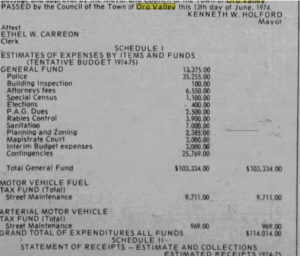
Town of Oro Valley 1974 First Budget
Due to an agreement with Rural Metro and Oro Valley, the department began with 2 1/2 full time equivalent employees covering the town 24 hours a day, seven days a week. The emphasis was on residential patrol and high visibility, and the police drove fire department green pickup trucks and a black and white pickup on loan to the Town from the fire department. As we all know, the current police department is very aware of speeding within our community, and that started out early, as well. Roof said that residents in the mid-1970s were demanding something be done to halt the sudden rash of traffic fatalities caused by drivers speeding through town and up and down Oracle Road. Driving 75 in a 45 mile an hour zone was not unusual, and people doing 55 and over in a 20 mile an hour zone was routine. There were also times that the police would be called to remove a stray cow from any of the neighborhood streets. That makes one wonder if that had anything to do with the $3,900 allotted for rabies control?
The other item that is interesting in this budget is over $25,000 for contingencies. It makes you think that the council just wasn’t sure what they were going to need, when they were going to need it, or how they were going to pay for it. At least they planned for those surprises, and aren’t we grateful that they did? Oro Valley is an incredible community, and we have these people to thank in our 50th year of celebration!
Written by Devon Sloan, July 2024
Imagine a 3,000+ square foot, four-bedroom, 3 bath home on one acre with mountain views, two indoor fireplaces, four car garage, with room for recreational vehicle parking, plus a pool and a spa in Oro Valley Country Club Estates. What a treasure! Well, you could have had that home in July 1974 for just $54,000! It had been built just 9 years before. Also, in July 1974 in the Oro Valley Townhouse development on Greenock Drive, a two bedroom, two bath, 2,757 square foot home was being sold for $34,750!
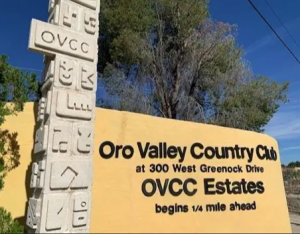
You must be asking ‘why would anyone leave those comfortable, magnificent homes in such a great location?’ Hopefully, it wasn’t because the owners were not in favor of the incorporation of Oro Valley and wanted to move out of the new town that was being formed, just 3 months after the incorporation was completed in April 1974. Looking back, that would have been a real mistake. Based on inflation over the past 50 years, the house would now be worth about $350,000, but with current real estate values, that home would sell for between $914,744 and $1,021,600! And the townhouse? Based on today’s dollars, the home is now worth $225,743 and based on real estate values $479,000. No matter where those homeowners moved to, it’s hard to believe they could have reaped such great rewards! Oro Valley truly is the Valley of Gold!
Happy Independence Day (and Incorporation Celebration) to All!
The turbulent path from April 1974 approval to the final 1975 decision that made the Town official. Written by Devon Sloan, August 2024
This year we are celebrating Oro Valley’s birth year month by month. Pima County approved the incorporation in April 1974, selected 5 people on the new Town Council (2 for incorporation, 2 against it, and one neutral), and ordered an election by the residents to be held in August 1974.
You would think that the new Town Council appointed in April would get to work and move forward to develop this new 2.5 square mile community with approximately 1,200 residents. Not so fast! Even after the approval, not all citizens of the new Town were convinced it was the right way to go.
For the August election, eleven people were on the ballot – 5 for incorporation, 5 against it, and one neutral. Voters were to select 5 to be on the Town Council until 1976, and those council members would select the Mayor. The Town Clerk at the time, said that about 632 people had registered to vote, and one of the candidates, then Mayor Kenneth Holford (the neutral candidate), said he expected a 70 – 80% turn out. He also stated that an election of an anti-incorporation slate would not automatically dissolve the Town, however he was less optimistic about the future of Oro Valley than he had been a month prior to this election.
At that time, the Town could be dis-incorporated if two thirds of registered voters signed a petition for dis-incorporation and presented it to the Board of Supervisors. The anti-incorporation candidates already had 387 signatures on their petition and needed only 35 more to accomplish their goal. At the end of the election period (going into October due to run-off elections), 4 of the 5 seats were then held by dis-incorporation candidates.
Throughout the time-period from August 1974 to August 1975, the Town citizens and Council had some contentious meetings about budget, sales taxes, services, recalls, zoning, and more. Even though Pima County had approved the municipality of Oro Valley in April 1974, it took until August 1975 for all the discussions to lead Pima County to turn down all petitions and finally make Oro Valley a town. The possibility of incorporation, which began as far back as 1968, was no longer an issue. Oro Valley was finally born.!
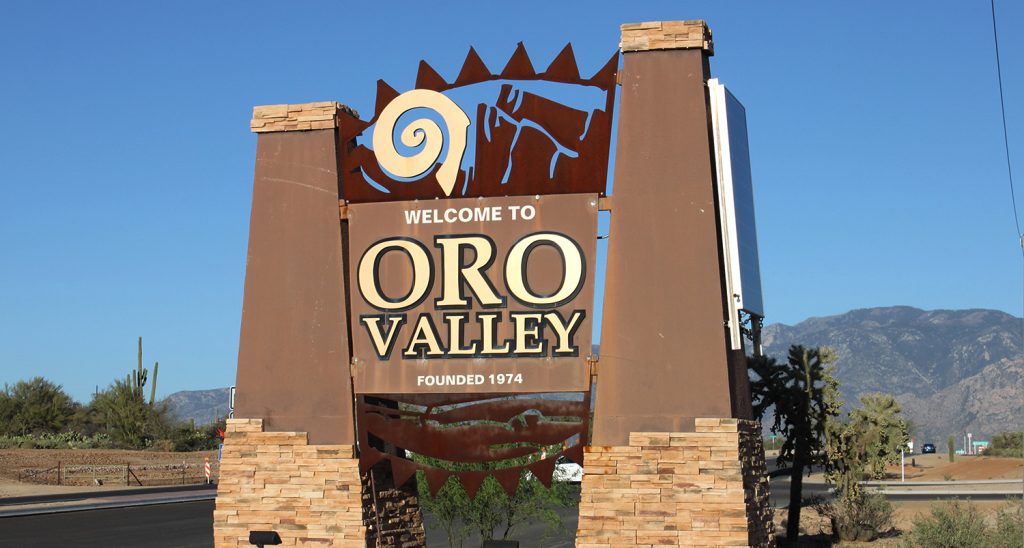
Written by Devon Sloan, November 2024
“You owe us $12,000!” That’s what the Board of Supervisors of Pima County told the 7- month- old Town of Oro Valley in November 1974. Articles in November issues of The Tucson Citizen and the Arizona Daily Star noted that Oro Valley was under contract each quarter to pay Pima County for police protection, rabies control, and sewer and sanitation services.
month- old Town of Oro Valley in November 1974. Articles in November issues of The Tucson Citizen and the Arizona Daily Star noted that Oro Valley was under contract each quarter to pay Pima County for police protection, rabies control, and sewer and sanitation services.
The Town offered to repay the debt in bi-weekly $2,000 installments until the end of the year. The County did not accept that offer and voted to cancel the contract for services. Councilman A. Lauren Rhude noted that “the county can cancel the contract, but it cannot withdraw its services,” and was critical of the supervisors for not formally advising the Oro Valley Council of its intentions regarding the delinquent bill.
A staff member of the County Attorney’s office noted that failure to meet the payment schedule could result in stopping services to the Town, refusing to pay the Town tax money owed it, or sue the Town and force it to assess a property tax.
Because of this situation, Vice Mayor, Virgil B. Brandon, who had voted against incorporation, resigned his position and worked on gathering signatures on disincorporation petitions. A newcomer to Oro Valley from Phoenix, also against incorporation, was appointed to fill the position. Some residents went to court to eliminate the contract between the County and the Town.
You can breathe a sigh of relief (since you know all that controversy was for naught because we live in this great Town today). A month later, the Town started collecting sales tax and permit fees and did pay off the debt. Services were never stopped. The Town received the tax money the County owed. No property tax was initiated. Again, the struggle to keep Oro Valley a Town was avoided. Happy ending for all of us!
Written by Devon Sloan, October 2024
The newly incorporated Town of Oro Valley has its first Town Council meeting of elected officials in October 1974. During the planning stages, beginning in 1968, those who wanted the Town to be incorporated held meetings in people’s homes in Oro Valley Country Club Estates and Shadow Mountain Estates. Larger meetings were held at Canyon del Oro High School when interested parties wanted to attend.
At this first meeting, the Council voted to rent a two-bedroom apartment on Oracle Road as office space. Obviously, there weren’t many departments making up this new Town government, so this worked for a while. It became obvious that as the Town grew, so did the governing entities, and more space was needed.
Two years later, the Town Hall was moved to a building on Calle Concordia, and Town residents were asked for donations of $10.00 per household to help pay for this purchase! The Town actually purchased the property in 1979. The second Town Hall on Calle Concordia, now houses the Town’s Storm Water Utility and Public Works Departments.
But as you know, the Town continued to grow and so did the staff and departments who serviced the community. More space was needed, and in 1988, Oro Valley purchased the land on which the current Town Hall is located. This new Town Hall was opened in 1991.
The following article is from the Oro Valley Historical Heritage Guide, April 2009 – by Marjorie Kriegh, wife of Jim Kriegh and first Town Historian for the Town of Oro Valley.
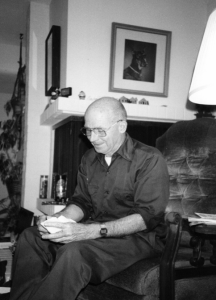
Jim Kriegh Planning for the Future in his Living Room
It is fact that the Town of Oro Valley has been happily incorporated since April 1974. But, perhaps, you have wondered how and why the Town of Oro Valley came to be.
Our story began long ago, way back in 1968. Tucson Mayor “Gentleman” Jim Corbett made a statement, which, to some area residents could be likened to the “shot heard round the world”. Well, ‘round Tucson, anyway. Mayor Corbett said that they (the areas around Tucson) will be taken in (to Tucson’s city limits) “kicking, stamping and screaming, if necessary”. The City of Tucson’s political climate, as it was at that time, was not to many people’s likings and many, many people living outside Tucson’s corporate limits wished to remain so. Some concerned citizens began to look at the feasibility of forming their own town in order to avoid being “absorbed” by the City of Tucson.
The State of Arizona, however, had done its part to discourage incorporation of areas on the “outskirts” of larger municipalities. A ruling came down from the legislature which stipulated that an area proposed for incorporation must have at least 500 inhabitants who all had to exhibit common goals and objectives. Additionally, to protect the larger cities, an area proposed for incorporation had to be farther than six miles from another incorporated city’s boundaries. If the proposed boundaries were not six miles apart, then permission by the incorporated city must be given. Larger cities and towns lobbied long and hard for these incorporation rulings because they did not wish to be hemmed in by a proliferation of “bedroom communities”; to avoid competition.
Some residents northwest of Tucson were undaunted by these rulings. With the competent legal advice of Mr. Ellsworth Triplett, for whom I served as legal secretary at the time, interested people began to organize. These people came from, not only the area later to become known as Oro Valley, but also, from the Catalina Foothills area.
There were obstacles to overcome. The “six-mile” rule made incorporation of the Catalina Foothills area impossible, but, as Mr. Triplett advised, the outlying area which included the Oro Valley Country Club Estates and the Highlands Mobile Home Park, could conceivably be incorporated since the area was six miles distant from the City of Tucson limits. (Later, the Highlands Mobile Home Park was dropped from the incorporation effort because less than 50% of the people favored the incorporation.) At this time, the proposed Town was to be named, The Town of Palo Verde.”
Because the Oro Valley Country Club Estates, under the direction of Mr. Robert Daly, President of the Homeowner’s Association, was undertaking street improvement, interest in the incorporation effort waned for a time, but was renewed when Mr. E. S. (Steve) Engle, the new Oro Valley Homeowner’s President became interested. Together with my husband, Jim Kriegh, they gathered citizen support from all areas proposed for incorporation, including Shadow Mountain Estates East and West, Campo Bello Estates, Linda Vista Citrus Tracts, and Oro Valley Country Club Estates.
Citizens from all these areas worked long and hard for many years, the culmination of their efforts being the filing of a petition for the incorporation of the Town of Oro Valley with the Pima County Board of Supervisors. As may have been suspected this petition was promptly rejected by the Board, leading to a four-year court battle which ended in the Arizona Supreme Court. The decision handed down by the Supreme Court directed the Pima County Board of Supervisors to incorporate our tiny 2.5 square mile Town of Oro Valley.
This decision signified the birth of the Town of Oro Valley on April 15, 1974, and the beginning of a Town which, it is hoped, all citizens may be proud of today.
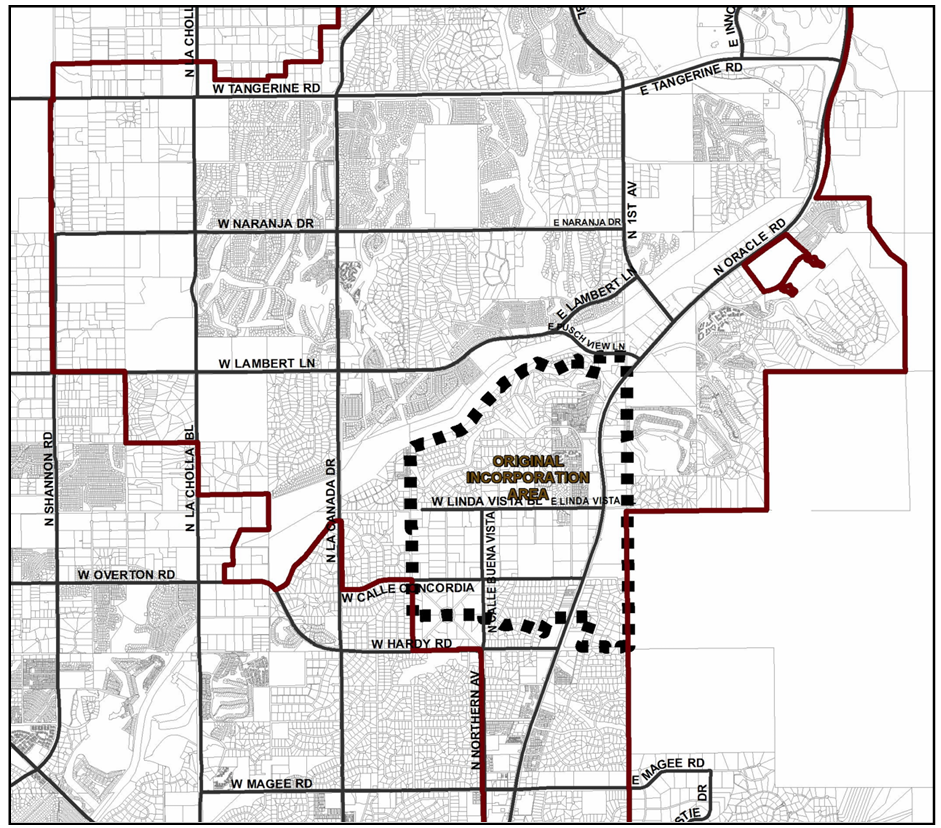
Map of Original Incorporation Area of Oro Valley
The Arizona Daily Star article is from April 26, 1984.
Marjorie Kriegh: A Woman Who Helped Build Oro Valley
OV Fought to Become, Then to Stay, a Town, by Dave Perry (featuring an interview with Twink Monrad)

Twink Monrad, 2024
Also by Dave Perry: The Story of How the Loop Came to Be. Thank you, Dave, for all of your contributions to Oro Valley!

Dave Perry